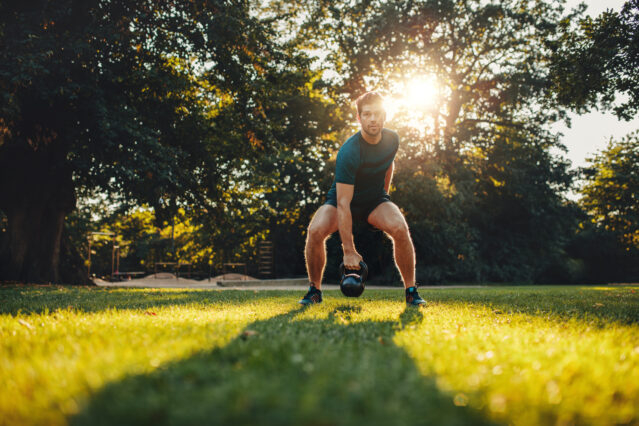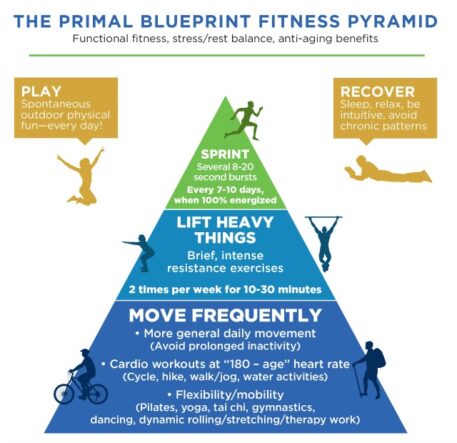---------------------------------------

There are certain fundamental inputs every person needs to be healthy: nutritious food, plenty of sleep, social connection, and the one we’re talking about today, movement.
Movement is an essential part of the Primal Blueprint master plan for crafting your strongest, fittest, most dynamic, most enjoyable life. That’s what I want for all my readers—a long life well lived until the end. To reach that goal, you need a strong foundation of physical health and mobility, starting as young as possible to stave off the inevitable physical decline that comes with age.
Everyone knows how to move. We’ve all heard that exercise is important, that we should be aiming for 10,000 steps a day, building core strength, and actually using our gym memberships. Yet many, nay most, people don’t do the right amount, either moving too little or too much (the former being far more common). Nor do they move in diverse enough ways to achieve their optimal fitness and longevity potential. In short, they don’t move in accordance with the Primal Blueprint.
What Does It Mean to Move Primally?
Humans are designed to move through the world. To be active. To physically manipulate our environments.
Our ancestors, of course, had no choice in the matter. They didn’t worry about becoming strong or physically competent. Their fitness was a natural result of living in an unforgiving environment that required them to work for everything—food, shelter, water, transportation, socializing, defense, and every other aspect of survival. But life is easy now, at least when it comes to physical demands. We modern folks do need to work at being fit.
When I was devising the Primal Blueprint, I considered how our ancestors moved, what qualities they embodied, and what, therefore, our genes need and expect for optimum health. Here’s what I came up with:
- Humans are designed to move a lot—mostly slowly, sometimes very fast.
- The human body is meant to move through all planes of motion: to push, pull, lift, jump, spring, sprint, throw, and balance.
- Our ancestors had to be physically strong, powerful, and quick on their feet, with a good strength-to-body weight ratio and plenty of endurance.
With this in mind, I came up with the following Primal Blueprint movement laws.
The Primal Blueprint Movement Laws
Four of the ten Primal Blueprint Laws speak to how you should be moving. It’s that important.
Primal Law #3: Move frequently.
We know that our ancestors spent, on average, several hours each day moving about at what today’s exercise physiologists might describe as a “low-level aerobic pace.” They hunted, gathered, foraged, wandered, scouted, migrated, climbed, and crawled. This low level of activity prompted their genes to build strong muscles, bones, and joints; to build a robust cardiovascular system; and to burn fat for fuel.
Today’s sedentary-dominant lifestyle is about as far from this as we could possibly get. Yet, our genes still expect us to move frequently, mostly at a slow pace. From a chronic health perspective, this is arguably one of the most detrimental discrepancies between Primal and modern life.
Read more about Primal Law #3 here.
Primal Law #4: Lift heavy things.
By the same token, until relatively recently, there was simply no way to get by without moving heavy things like wood, stone, water, animals killed many miles from home, and one’s own body weight. Moving heavy things, what we’d now call “resistance training” when done in an exercise setting, makes you strong.
Strength isn’t just about having an attractive physique or succeeding in sport, although those are perfectly good reasons to want to be strong. Muscle is metabolically active tissue and a major repository for blood glucose (glycogen). Too little muscle means a greater risk for insulin resistance and metabolic dysfunction. A weak musculoskeletal system equals frailty, and frailty is strongly associated with mortality as we age.
Read more about Primal Law #4 here.
Primal Law #5: Sprint once in a while.
Going all-out delivers a powerful signal to your genes, telling them, “Hey, we need to be ready to perform at maximum capacity at a moment’s notice.” For Primal humans, this would have been a matter of life and death. The resultant hormonal cascade and adaptation make the body fitter and more resilient to future challenges.
Read more about Primal Law #5 here.
Primal Law #7: Play.
(Yes, I skipped Law #6. It’s covered in the Primal Lifestyle Laws post.)
Hunter-gatherers generally worked fewer hours and had more leisure time than the average 40-hour-plus American worker. Once the day’s catch was complete, and the roots, shoots, nuts, and berries had been gathered, our ancestors spent hours involved in various forms of social interaction that we might categorize today as “play.”
The net effect was to solidify social bonds and sort out the social hierarchy, stimulate creative thinking and problem solving, practice important skills like climbing or spear throwing in a low-stakes environment, and pass on wisdom. Play was also important to prompt the release of endorphins (feel-good brain chemicals) and to mitigate any lingering stress effects of life-threatening situations.
You might not need to be adept at spear throwing in your daily life, but the other benefits of play remain as relevant today as ever for kids and adults alike.
Read more about Primal Law #7 here.
Putting the Movement Laws into Action
The Primal Blueprint Fitness Pyramid provides a handy visual reference for how I think the average person should move in a week’s time (more or less).

Within this general framework, there’s plenty of room for you to find ways to move that you enjoy. I think of the Primal Blueprint as endlessly malleable, eternally scalable. Maybe your goal is to hike the Pacific Crest Trail. Maybe it’s to be able to spend the whole day on your feet at Disney World with your family. Maybe you love CrossFit or you want to run your first 5k. Maybe your job requires that you meet certain physical fitness standards. Perhaps you just want to live a long, healthy life, but you never want to see the inside of a gym. These are all valid. As I’ve said before, the best exercise is the one you will do consistently.
Whatever your goals, the Primal Blueprint Movement Laws provide a springboard to build a broad base of fitness. Crucially, the Primal Blueprint will also help you avoid the pitfalls of chronic cardio and other overly stressful exercise patterns.
These movement laws provide the right formula for getting lean and functionally fit for life with minimal time commitment, pain, suffering, and sacrifice—and, more importantly, with as much fun, enjoyment and ease as possible. It’s not the only way to get fit, but it might just be the most efficient, effective, and pleasurable way.
The Primal Blueprint, and the book of the same name, offers a framework for achieving your personal best health, vitality, and longevity. It is organized into 10 Primal Laws derived from anthropology, sociology, biology, psychology, and common sense. These laws describe the diet, movement, and lifestyle practices that lead to optimal gene expression—the practices that have allowed humans to thrive for hundreds of thousands of years, but which many people struggle to achieve in the modern world.
The post How to Move and Get Fit the Primal Way appeared first on Mark's Daily Apple.
-----------------------------------------
By: Mark Sisson
Title: How to Move and Get Fit the Primal Way
Sourced From: www.marksdailyapple.com/primal-movement/
Published Date: Fri, 15 Dec 2023 05:02:34 +0000
Read More
Did you miss our previous article...
https://prohealthsciences.com/general-health-and-wellness/a-new-drug-compound-shows-promise-for-schizophrenia
 General Health and WellnessFitness and ExerciseSupplements and VitaminsPandemic NewsVideosPrivacy PolicyTerms And Conditions
General Health and WellnessFitness and ExerciseSupplements and VitaminsPandemic NewsVideosPrivacy PolicyTerms And Conditions
